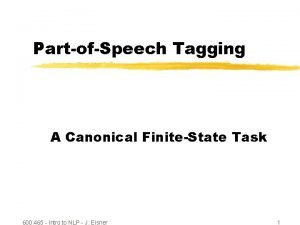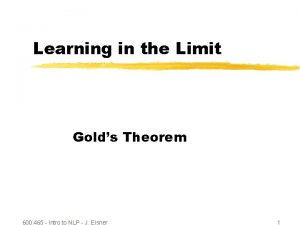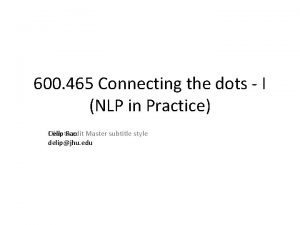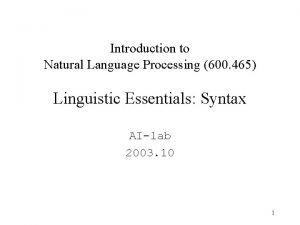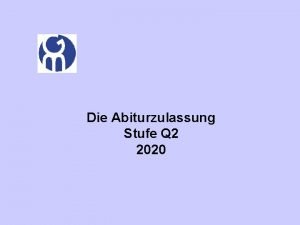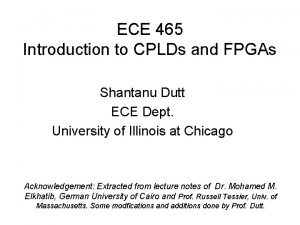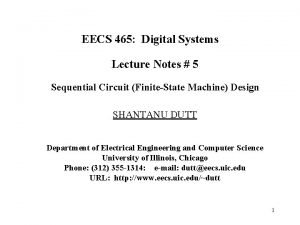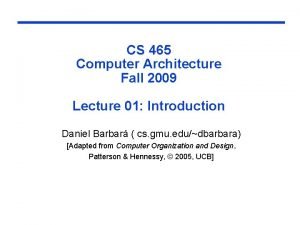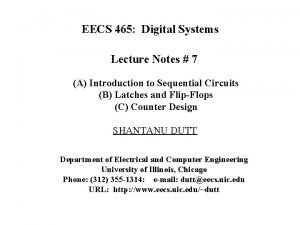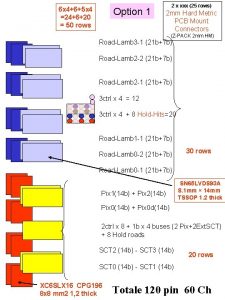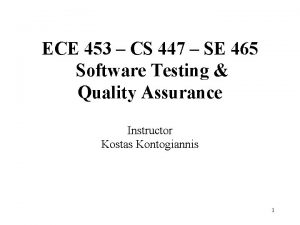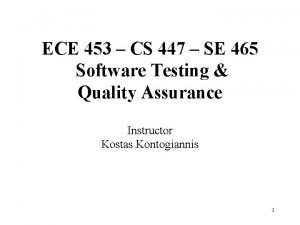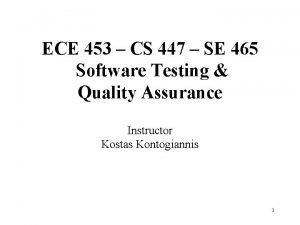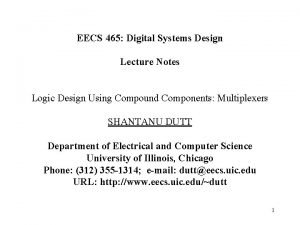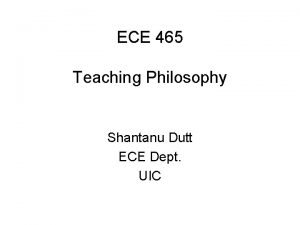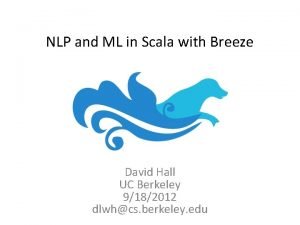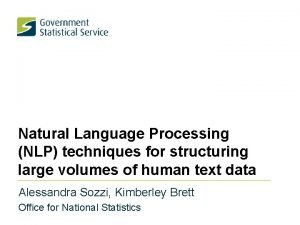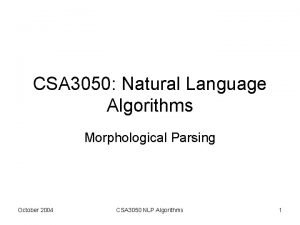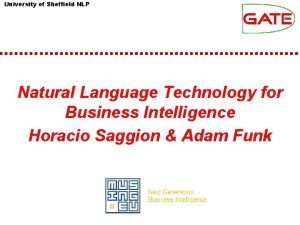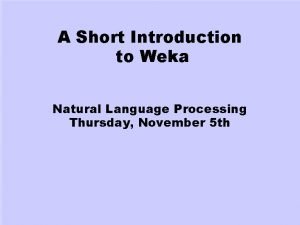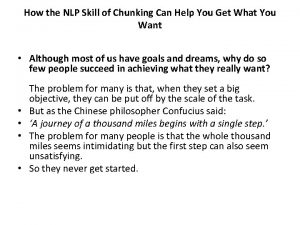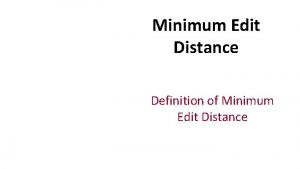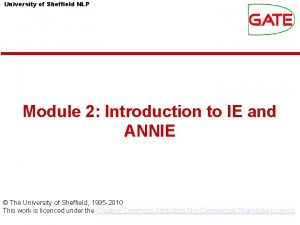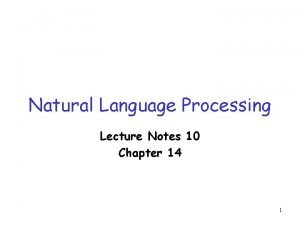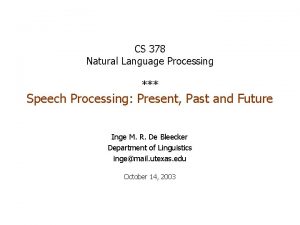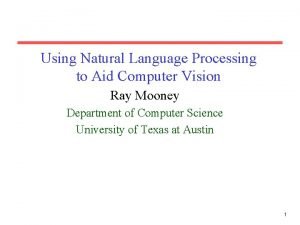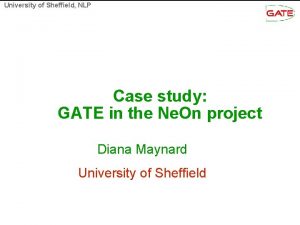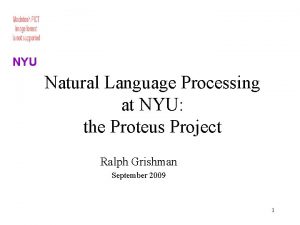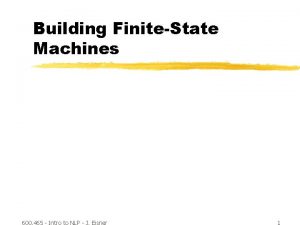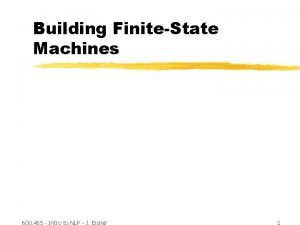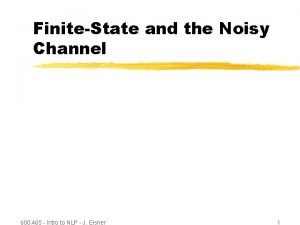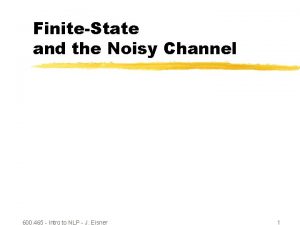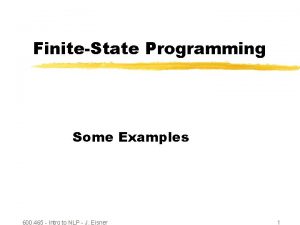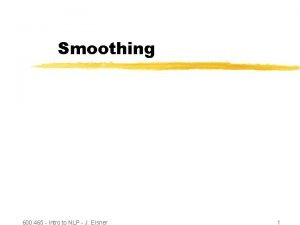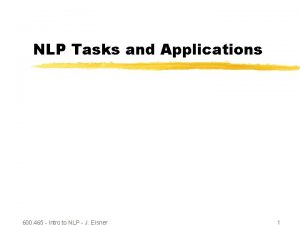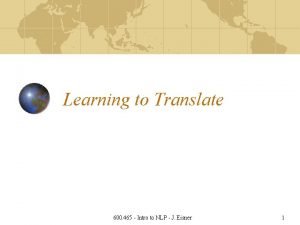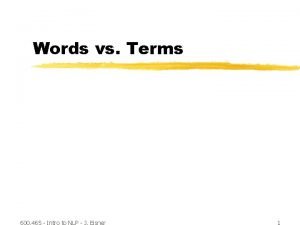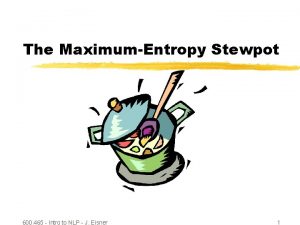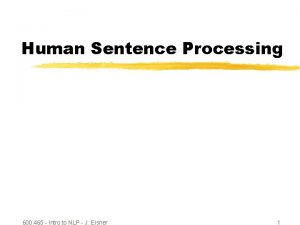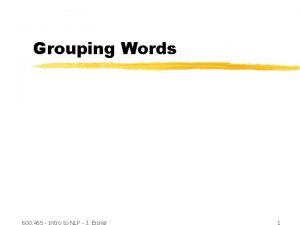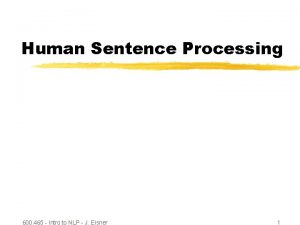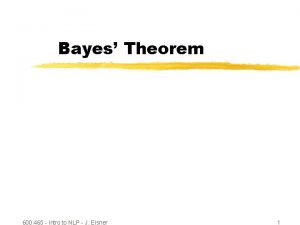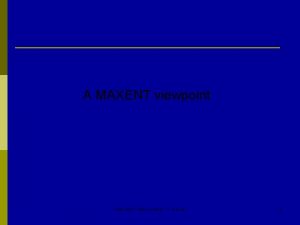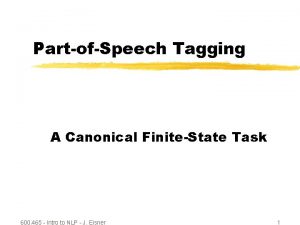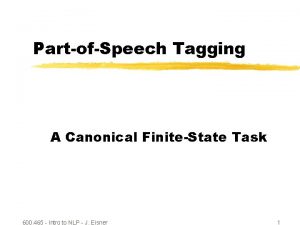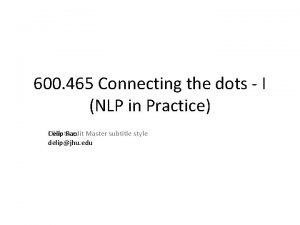FiniteState Methods 600 465 Intro to NLP J









![Example: Morphology VP [head=vouloir, . . . ] V[head=vouloir, . . . tense=Present, num=SG, Example: Morphology VP [head=vouloir, . . . ] V[head=vouloir, . . . tense=Present, num=SG,](https://slidetodoc.com/presentation_image/35a88029a1d703585ed33e34d454df35/image-10.jpg)


























![FASTUS : Basic phrases Output looks like this (no nested brackets!): … [NG it] FASTUS : Basic phrases Output looks like this (no nested brackets!): … [NG it]](https://slidetodoc.com/presentation_image/35a88029a1d703585ed33e34d454df35/image-37.jpg)




- Slides: 41

Finite-State Methods 600. 465 - Intro to NLP - J. Eisner 1

Finite state acceptors (FSAs) § Things you may know about FSAs: c a Defines the language a? c* = {a, acc, accc, …, , c, ccc, …} 600. 465 - Intro to NLP - J. Eisner § Equivalence to regexps § Union, Kleene *, concat, intersect, complement, reversal § Determinization, minimization § Pumping, Myhill-Nerode 2

n-gram models not good enough § Want to model grammaticality § A “training” sentence known to be grammatical: BOS mouse traps catch mouse traps EOS trigram model must allow these trigrams § Resulting trigram model has to overgeneralize: § allows sentences with 0 verbs BOS mouse traps EOS § allows sentences with 2 or more verbs BOS mouse traps catch mouse traps EOS § Can’t remember whether it’s in subject or object (i. e. , whether it’s gotten to the verb yet) 600. 465 - Intro to NLP - J. Eisner 3

Finite-state models can “get it” § Want to model grammaticality BOS mouse traps catch mouse traps EOS § Finite-state can capture the generalization here: Noun+ Verb Noun+ Noun Verb preverbal states (still need a verb to reach final state) 600. 465 - Intro to NLP - J. Eisner Noun postverbal states (verbs no longer allowed) Allows arbitrarily long NPs (just keep looping around for another Noun modifier). Still, never forgets whether it’s preverbal or postverbal! (Unlike 50 -gram model) 4

How powerful are regexps / FSAs? § More powerful than n-gram models § The hidden state may “remember” arbitrary past context § With k states, can remember which of k “types” of context it’s in § Equivalent to HMMs § In both cases, you observe a sequence and it is “explained” by a hidden path of states. The FSA states are like HMM tags. § Appropriate for phonology and morphology Word = = Syllable+ (Onset Nucleus Coda? )+ (C+ V+ C*)+ ( (b|d|f|…)+ (a|e|i|o|u)+ (b|d|f|…)* )+ 600. 465 - Intro to NLP - J. Eisner 5

How powerful are regexps / FSAs? § But less powerful than CFGs / pushdown automata § Can’t do recursive center-embedding § Hmm, humans have trouble processing those constructions too … § This is the rat that ate the malt. § This is the malt that the rat ate. § This is the cat that bit the rat that ate the malt. § This is the malt that the rat the cat bit ate. finite-state can handle this pattern (can you write the regexp? ) § This is the dog that chased the cat that bit the rat that ate the malt. § This is the malt that [the rat that [the cat that [the dog chased] bit] ate]. but not this pattern, which requires a CFG 600. 465 - Intro to NLP - J. Eisner 6

How powerful are regexps / FSAs? § But less powerful than CFGs / pushdown automata § More important: Less explanatory than CFGs § An CFG without recursive center-embedding can be converted into an equivalent FSA – but the FSA will usually be far larger § Because FSAs can’t reuse the same phrase type in different places Noun Verb duplicated structure Noun c co on pi ve es rt th ing e to N P FS tw A ic e S= Noun duplicated structure S= 600. 465 - Intro to NLP - J. Eisner more elegant – using nonterminals like this is equivalent to a CFG Noun NP = NP Verb Noun NP 7

Strings vs. String Pairs § FSA = “finite-state acceptor” § Describes a language (which strings are grammatical? ) § FST = “finite-state transducer” § Describes a relation (which pairs of strings are related? ) § underlying form surface form § sentence translation § original edited §… 600. 465 - Intro to NLP - J. Eisner 8

Example: Edit Distance position in upper string c a: r: a a: c r: a: c a: r: a: : c : c l: a: r: a : a : a l: a: : a r: : a a: c position in lower string c r: a: l: : c : c : c l: a: r: a: c: a a 4 5 a c a: a 600. 465 - Intro to NLP - J. Eisner : c a : a a: l: 3 4 c c l: : c r: c: 2 3 c c: : a a: c: 1 2 a : c c: Cost of best path relating these two strings? l: c c: 0 0 c: 1 : a : a : a l: a: r: a: c: 9
![Example Morphology VP headvouloir Vheadvouloir tensePresent numSG Example: Morphology VP [head=vouloir, . . . ] V[head=vouloir, . . . tense=Present, num=SG,](https://slidetodoc.com/presentation_image/35a88029a1d703585ed33e34d454df35/image-10.jpg)
Example: Morphology VP [head=vouloir, . . . ] V[head=vouloir, . . . tense=Present, num=SG, person=P 3] veut 600. 465 - Intro to NLP - J. Eisner 10

slide courtesy of L. Karttunen (modified) Example: Unweighted transducer VP [head=vouloir, . . . ] vouloir +Pres +Sing + P 3 V[head=vouloir, . . . Finite-state transducer tense=Present, num=SG, person=P 3] veut canonical form v o u v e u l the relevant path 600. 465 - Intro to NLP - J. Eisner o inflection codes i r +Pres inflected form +Sing +P 3 t 11

slide courtesy of L. Karttunen Example: Unweighted transducer § Bidirectional: generation or analysis § Compact and fast § Xerox sells for about 20 languges including English, German, Dutch, French, Italian, Spanish, Portuguese, Finnish, Russian, Turkish, Japanese, . . . § Research systems for many other languages, including Arabic, Malay vouloir +Pres +Sing + P 3 Finite-state transducer veut canonical form v o u v e u l the relevant path 600. 465 - Intro to NLP - J. Eisner o inflection codes i r +Pres inflected form +Sing +P 3 t 12

Regular Relation (of strings) § Relation: like a function, but multiple outputs ok § Regular: finite-state a: § Transducer: automaton w/ outputs b: b § b {b} ? a ? {} § aaaaa {ac, ? aca, acabc} § Invertible? § Closed under composition? 600. 465 - Intro to NLP - J. Eisner a: a a: c ? : c b: b b: ? : b ? : a 13

Regular Relation (of strings) § Can weight the arcs: vs. § b {b} a {} § aaaaa {ac, acab, acabc} a: b: b a: a § How to find best outputs? § For aaaaa? § For all inputs at once? 600. 465 - Intro to NLP - J. Eisner a: c ? : c b: b b: ? : b ? : a 14

Function from strings to. . . Acceptors (FSAs) Unweighted c {false, true} a c/. 7 a/. 5. 3 /. 5 600. 465 - Intro to NLP - J. Eisner c: z strings a: x : y numbers Weighted Transducers (FSTs) (string, num) pairs c: z/. 7 a: x/. 5. 3 : y/. 5 15

Sample functions Acceptors (FSAs) Unweighted Weighted Transducers (FSTs) {false, true} strings Grammatical? Markup Correction Translation numbers (string, num) pairs How grammatical? Better, how likely? Good markups Good corrections Good translations 600. 465 - Intro to NLP - J. Eisner 16

Terminology (acceptors) Regular language defines recognizes compiles into Regexp FSA s pt ne ce ge ac e ch s e ch (or t ma ra s te s) implements String 600. 465 - Intro to NLP - J. Eisner 17

Terminology (transducers) Regular relation defines recognizes compiles into Regexp c ac e ch s (or t ma (or gen ept on , tra erat s e th str nsdu es) e p in c th ai g o es eo ri f th nto er ) implements String pair 600. 465 - Intro to NLP - J. Eisner FST ? 18

Perspectives on a Transducer § Remember these CFG perspectives: 3 views of a context-free rule § § § generation (production): S NP VP (randsent) parsing (comprehension): S NP VP (parse) verification (checking): S = NP VP § Similarly, 3 views of a transducer: § Given 0 strings, generate a new string pair (by picking a path) § Given one string (upper or lower), transduce it to the other kind § Given two strings (upper & lower), decide whether to accept the pair v o u v e u l o i r +Pres +Sing +P 3 t FST just defines the regular relation (mathematical object: set of pairs). What’s “input” and “output” depends on what one asks about the relation. The 0, 1, or 2 given string(s) constrain which paths you can use. 600. 465 - Intro to NLP - J. Eisner 19

Functions ab? d abcd f 600. 465 - Intro to NLP - J. Eisner g 20

Functions abcd ab? d Function composition: f g [first f, then g – intuitive notation, but opposite of the traditional math notation] 600. 465 - Intro to NLP - J. Eisner 21

From Functions to Relations f ab? d g 3 2 6 abcd abed 4 2 8 abjd abcd ab d. . . 600. 465 - Intro to NLP - J. Eisner 22

From Functions to Relations ab? d 3 4 2 2 Relation composition: f g 6 8 abcd ab d. . . 600. 465 - Intro to NLP - J. Eisner 23

From Functions to Relations 3+4 ab? d 2+2 Relation composition: f g 6+8 abcd ab d. . . 600. 465 - Intro to NLP - J. Eisner 24

From Functions to Relations ab? d 2+2 Pick min-cost or max-prob output ab d Often in NLP, all of the functions or relations involved can be described as finite-state machines, and manipulated using standard algorithms. 600. 465 - Intro to NLP - J. Eisner 25

slide courtesy of L. Karttunen (modified) Building a lexical transducer c l e e big | clear | clever | ear | fat |. . . Regular Expression Lexicon f a t a v h r e Lexicon FSA Compiler Lexical Transducer (a single FST) composition Regular Expressions for Rules Composed Rule FSTs b i g one path 600. 465 - Intro to NLP - J. Eisner +Adj g +Comp e r 26

slide courtesy of L. Karttunen (modified) Building a lexical transducer c l e e big | clear | clever | ear | fat |. . . Regular Expression Lexicon f a t a v h r e Lexicon FSA § Actually, the lexicon must contain elements like big +Adj +Comp § So write it as a more complicated expression: (big | clear | clever | fat |. . . ) +Adj ( | +Comp | +Sup) adjectives | (ear | father |. . . ) +Noun (+Sing | +Pl) nouns |. . . § Q: Why do we need a lexicon at all? 600. 465 - Intro to NLP - J. Eisner 27

Inverting Relations f ab? d g 3 4 abcd 2 2 abed ab d 6 8 abjd ab d. . . 600. 465 - Intro to NLP - J. Eisner 28

Inverting Relations f g-1 -1 ab? d 3 4 abcd 2 2 abed ab d 6 8 abjd ab d. . . 600. 465 - Intro to NLP - J. Eisner 29

Inverting Relations 3+4 ab? d 2+2 (f g)-1 = g-1 f -1 6+8 abcd ab d. . . 600. 465 - Intro to NLP - J. Eisner 30

slide courtesy of L. Karttunen (modified) Weighted version of transducer: Assigns a weight to each string pair être+Ind. P +SG + P 1 suivre+Ind. P+SG+P 1 “upper language” suivre+Ind. P+SG+P 2 4 19 payer+Ind. P+SG+P 1 suivre+Imp+SG + P 2 20 12 Weighted French Transducer 50 3 suis 600. 465 - Intro to NLP - J. Eisner “lower language” paie paye 31

Composition Cascades § You can build fancy noisy-channel models by composing transducers … § Examples: § Phonological/morphological rewrite rules? § English orthography English phonology Japanese orthography § e. g. ? ? ? goruhubaggu § Information extraction 600. 465 - Intro to NLP - J. Eisner 32

FASTUS – Information Extraction Appelt et al, 1992 -? Input: Bridgestone Sports Co. said Friday it has set up a joint venture in Taiwan with a local concern and a Japanese trading house to produce golf clubs to be shipped to Japan. The joint venture, Bridgestone Sports Taiwan Co. , capitalized at 20 million new Taiwan dollars, will start production in January 1990 with … Output: Relationship: Entities: TIE-UP “Bridgestone Sports Co. ” “A local concern” “A Japanese trading house” Joint Venture Company: “Bridgestone Sports Taiwan Co. ” Amount: NT$20000000 600. 465 --Introto to. NLP--J. J. Eisner 33

FASTUS: Successive Markups (details on subsequent slides) Tokenization. o. Multiwords. o. Basic phrases (noun groups, verb groups …). o. Complex phrases. o. Semantic Patterns. o. Merging different references 600. 465 --Introto to. NLP--J. J. Eisner 34

FASTUS: Tokenization § § Spaces, hyphens, etc. wouldn’t would not their them ’s company. but Co. 600. 465 --Introto to. NLP--J. J. Eisner 35

FASTUS: Multiwords § “set up” § “joint venture” § “San Francisco Symphony Orchestra, ” “Canadian Opera Company” § … use a specialized regexp to match musical groups. §. . . what kind of regexp would match company names? 600. 465 --Introto to. NLP--J. J. Eisner 36
![FASTUS Basic phrases Output looks like this no nested brackets NG it FASTUS : Basic phrases Output looks like this (no nested brackets!): … [NG it]](https://slidetodoc.com/presentation_image/35a88029a1d703585ed33e34d454df35/image-37.jpg)
FASTUS : Basic phrases Output looks like this (no nested brackets!): … [NG it] [VG had set_up] [NP a joint_venture] [Prep in] … Company Name: Verb Group: Noun Group: Preposition: Location: Preposition: Noun Group: Bridgestone Sports Co. said Friday it had set up a joint venture in Taiwan with a local concern 600. 465 --Introto to. NLP--J. J. Eisner 37

FASTUS: Noun Groups Build FSA to recognize phrases like approximately 5 kg more than 30 people the newly elected president the largest leftist political force a government and commercial project Use the FSA for left-to-right longest-match markup What does FSA look like? See next slide … 600. 465 --Introto to. NLP--J. J. Eisner 38

FASTUS: Noun Groups Described with a kind of non-recursive CFG … (a regexp can include names that stand for other regexps) NG Pronoun | Time-NP | Date-NP NG (Det) (Adjs) Head. Nouns … Adjs sequence of adjectives maybe with commas, conjunctions, adverbs … Det. NP | Det. Non. NP Det. NP detailed expression to match “the only five, another three, this, many, hers, all, the most …” … 600. 465 --Introto to. NLP--J. J. Eisner 39

FASTUS: Semantic patterns Business. Relationship = Noun. Group(Company/ies) Verb. Group(Set-up) Noun. Group(Joint. Venture) with Noun. Group(Company/ies) | … Production. Activity = Verb. Group(Produce) Noun. Group(Product) Noun. Group(Company/ies) Noun. Group & … is made easy by the processing done at a previous level Use this for spotting references to put in the database. 600. 465 --Introto to. NLP--J. J. Eisner 40

Composition Cascades § You can build fancy noisy-channel models by composing transducers … § … now let’s turn to how you might build the individual transducers in the cascade. § We’ll use a variety of operators that combine simpler transducers and acceptors into more complex ones. § Composition is just one example. 600. 465 - Intro to NLP - J. Eisner 41
 600-465
600-465 600-465
600-465 600-465
600-465 600-465
600-465 Nilai dari sin 600 + tg 600 adalah
Nilai dari sin 600 + tg 600 adalah 465 punkte abi
465 punkte abi Ece 465
Ece 465 Eecs 465
Eecs 465 Gmu cs 465
Gmu cs 465 Eecs 465
Eecs 465 Call graph based integration
Call graph based integration Eecs 465
Eecs 465 465 x 4
465 x 4 Cs 447
Cs 447 Se 465
Se 465 Se 465
Se 465 Eecs 465
Eecs 465 Se 465
Se 465 Shantanu dutt
Shantanu dutt Direct wax pattern technique
Direct wax pattern technique Nlp
Nlp Search engine architecture
Search engine architecture Nlp login
Nlp login What is nlp techniques
What is nlp techniques Morphological parsing in nlp
Morphological parsing in nlp Sheffield nlp
Sheffield nlp Natural language processing
Natural language processing Nlp training thailand
Nlp training thailand Weka nlp
Weka nlp Nlp chunking
Nlp chunking Needleman wunsch
Needleman wunsch Annie nlp
Annie nlp Nlp login
Nlp login Fopc in nlp
Fopc in nlp Why is nlp hard in terms of ambiguity?
Why is nlp hard in terms of ambiguity? Cs378 nlp
Cs378 nlp Natural language processing nlp - theory lecture
Natural language processing nlp - theory lecture Computer vision vs nlp
Computer vision vs nlp Natural language processing fields
Natural language processing fields Gate nlp
Gate nlp Reframing in nlp
Reframing in nlp Adam meyers nyu
Adam meyers nyu
